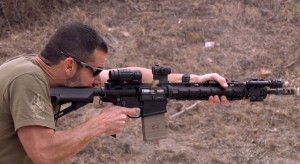Army Seeks Patent On Durable Solid Lubricant
BY Herschel SmithWhat if you never had to clean and lubricate your rifle again?
Army engineers at Picatinny Arsenal believe they’ve cracked the code to make it happen with a new surface applicant, which they said could go into production in 2018.
When rifles and machine guns are fired, byproducts accumulate, leading to what’s known as “fouling.” Buildup of powder residue and moisture can eventually cause the weapon to jam, or lose accuracy, reliability and cyclic rate (rounds per minute). That’s why soldiers have to clean their rifles, generally with a wet lubricant known as CLP (cleaner, lubricant and preservative).
The new material, known as durable solid lubricant, would be applied during manufacturing and coats the weapon’s moving parts. DSL simply prevents material from sticking to the weapon’s surface. Since the fouling buildup only loosely adheres to a DSL surface, any force from the other moving parts or vibrations from firing is enough to knock it loose and keep the rifle clean.
“We see this as a major breakthrough in a technology that hasn’t been able to demonstrate performance like this in the past,” said Adam Foltz, an experimental engineer at Picatinny working on the project.
Christopher Mulligan, a research engineer who has a doctorate in materials science and has worked for Army Research, Development and Engineering Command for 13 years, said the material is a hard coating that drastically reduces friction and corrosion, improving the rifle’s reliability. Explosive byproducts don’t stick to the material, he said. The Army has a patent pending on DSL; he and Foltz didn’t want to go into detail on the technology until the patent is approved.
Testing so far has been limited but encouraging, the two said. A 10,000-round test of an M4A1, for example, produced zero stoppages despite testers never cleaning the gun, Foltz said. “The only time we weren’t shooting was to let the barrel cool.” There have been other tests that, while lab-based, incorporated sand, mud and extreme temperatures.
Not only does DSL make a rifle easier to maintain, but it greatly reduces wear thanks to removal of CPL. The oil mixes with phosphate and hot propellant gas produced by firing, which increases the volume of a buildup that can erode a weapon’s moving parts, Mulligan said. The engineers provided an image depicting test results which they say show parts of a bolt and bolt carrier 50 percent to 90 percent worn after firing 15,000 rounds while treated with CLP. The DSL-coated parts showed wear ranging from 10 percent to less than 5 percent on the same parts over the same use.
In order to keep Dr. Christopher Mulligan employed, it takes a lot of money. Ph.D. engineers don’t come cheap, and their research time doesn’t either. Paying an engineer for five or six years to do one thing in hopes that the entire project doesn’t fail for lack of viability is a pricey endeavor, tailor made for endurance rather than sprint.
This is just the kind of thing they would use tax money for, and that brings to mind the following question. Why is the Army seeking a patent on this? A patent is an odd thing to attach to this project, and is normally reserved for use when money is at stake.
For something like a secret project involving DARPA, or perhaps some project involving the nuclear assets of the nation I can see the need for secrecy, FOUO and other types of classifications. But what’s the intent here? Does the Army intend to sell it, or perhaps prevent some company inside of the states from reverse engineering this and marketing it?
When the national laboratories conduct work and research, normally the results of their work are in the public domain unless it involves secrecy (such as with the nuclear program). The idea is that if tax money has been used to create the intellectual property, then taxpayers own it.
And it’s not such a bad idea. So why is the Army seeking a patent on this technology?




